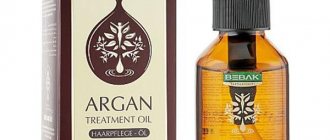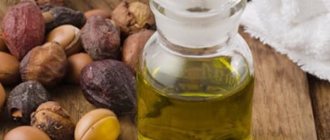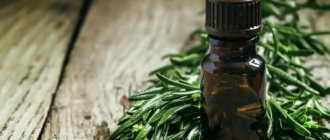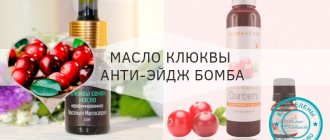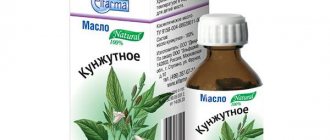For safe and gentle facial skin care at home, use cosmetics with the addition of various medicinal herbs. For these purposes, sage is suitable - a plant that improves the condition and color of the skin, and has a positive effect on beauty in general. Sage is used to prepare masks, creams, lotions and tonics for the face.
Thanks to the plant extract in the cosmetic product, the consistency acquires astringent, cleansing, anti-inflammatory and lifting properties. The use of sage in cosmetology will help maintain youthful and healthy skin for a long time. Decoctions are recommended to be taken orally to improve health in general, and as a treatment for specific pathologies.
Composition and medicinal properties of sage
The medicinal plant is characterized by a high content of beneficial substances that will help eliminate most cosmetic problems. The chemical composition and concentration of active components may vary depending on the place of growth and timing of collection.
| Valuable substances | Medicinal properties |
| Borneol | It has an antifungal effect, stops the proliferation of pathogenic microflora, relieves inflammation and eliminates ulcers and pigmentation. Stimulates the uniform distribution of melanin in tissues. |
| Flavonoids | Maintains skin elasticity, preventing the appearance of sagging. Reduce the likelihood of infectious pathologies and oncology. |
| Camphor | Softens the skin and makes it elastic. Effectively tightens pores, removes dead cells, cleanses sebaceous ducts. Makes the relief smooth. |
| Ursolic acid | It is highly effective in the treatment of dermatological problems (acne, eczema, blackheads). Stimulates tissue regeneration, accelerating the healing of wounds and microcracks. |
| Thujon | It is a toxic substance, but at low concentrations it tones the skin and stimulates blood circulation. Improves complexion, relieves puffiness. Increases the firmness and elasticity of skin tissue, which is an effective prevention of premature aging. |
| Carnosic acid | Helps remove free radicals from epidermal tissue. Has a rejuvenating effect and reduces the negative effects of ultraviolet radiation. |
| Cineole | Corrects sebum production, providing a matte skin effect, and normalizes metabolic processes. Has an antiseptic effect. |
| Vitamins P and PP | Strengthens the walls of capillaries, reducing their fragility. They improve the enrichment of tissue cells with oxygen, resulting in the skin acquiring a healthy, even color. |
| Salvin | Tones and strengthens capillaries. Prevents skin irritation. Protects it from the negative effects of external factors. |
| Minerals | They make the skin smooth, provide a beautiful even tone, and slow down age-related changes. Deficiency provokes inflammation and rapid aging of the skin. |
| Vitamins A, C, group B | They refresh, normalize regeneration processes, and tone the skin. Effective for the prevention of acne and inflammation of the epidermis. |
Beneficial properties for facial skin
Thanks to the rich content of nutrients in sage, it is able to eliminate almost any dermatological disorders and stop the withering process.
Useful properties of the plant:
- Rejuvenating. Slows down age-related changes by activating the production of collagen in cells. Used to prevent the formation of wrinkles and reduce the depth of existing ones.
- Antibacterial, disinfectant, and anti-inflammatory. Used to eliminate skin rashes.
- Lifting. Helps eliminate double chin, tightens jowls.
- Drying, astringent. Used to prepare care products for oily skin types. Eliminates greasy shine, mattifying the skin.
- Cleansing. Effectively removes clogged pores, removes blackheads and dead skin cells and removes toxins.
- Medicinal. Relieves symptoms and accelerates recovery in most dermatological pathologies.
- Strengthening. Stimulates lymph and blood flow.
- Protective. Reduces the negative impact of ultraviolet rays on the epidermis.
- Wound healing. Used to treat burns and injuries.
This is not a complete list of beneficial properties that sage has when used in cosmetology. It has an excellent whitening effect, effectively removing pigmentation on the face, and also relieves puffiness.
A little history
Photo by Emilia Zabrocka on Unsplash
Sage comes from the Mediterranean countries. Hippocrates himself mentioned it in his medical works and called it a “magic herb.” Many healers also used the plant to treat various ailments.
And ancient women even used sage as a cure for infertility, and this can be explained because the herb contains phytoestrogens very close to female sex hormones.
Therefore, even today the plant is used in gynecology. Sage also finds its use in cosmetology.
On jars of care products you can see the name Salvia - this is how sage is translated from Latin. In this article we will talk about its medicinal properties, and also look at how you can include weed in your daily facial care, and what are the indications and contraindications for this.
Who is it shown to?
Sage for the face is recommended for use in the following cases:
- presence of pigmentation;
- for the treatment of inflammation, acne;
- excessive sebum production;
- presence of cracks and scratches;
- aging skin.
This product restores elasticity to the skin, stimulates its renewal, and rejuvenates. Cosmetic procedures using products containing sage are recommended for problematic and oily skin, as the medicinal plant has a pronounced antiseptic effect.
Contraindications
Cosmetics containing sage are not recommended for use if the skin is hypersensitive to the product. To ensure the safety of the product, it is necessary to conduct a test to determine the skin's reaction to contact with the plant. To do this, apply the composition to the skin of the wrist. Check after 15 minutes. If redness and rashes appear, use of the product is strictly prohibited.
Carrying out cosmetic procedures with sage is contraindicated during the period of bearing a child, as well as in the presence of a history of bronchial asthma. Use the oil with caution if you have hypertension.
It is important not to exceed the dosage indicated in the recipe. An increase in concentration can provoke a general deterioration in health and cause disturbances in the functioning of the central nervous system.
Where is the best place to buy
Sage oil is a fairly common ether and can be purchased at a pharmacy or natural cosmetics store. It’s easy to choose the product you like on the Internet by filling out an application.
When purchasing, you need to pay attention to the packaging; the oil is sold in a dark glass bottle with a dispenser. The Latin name must also be indicated - Salvia officinalis, Salvia sclarea. The price of 5.10 ml varies from 120 to 2000 rubles.
The oil should be stored at room temperature, avoiding exposure to sunlight. The shelf life is 5 years, it is difficult to determine the spoiled ether, it has an intense bright aroma. You should not rely on external indicators; the main criterion for checking the freshness of the oil is the production date indicated on the packaging.
Sage hydrolate
The liquid obtained by steam distillation is called hydrolate. The steam condenses as it passes through the flowers and leaves of the plant, enriching itself with unique and beneficial substances. Sage hydrolate is a medicinal liquid containing water-soluble beneficial elements.
The product has the following cosmetic properties:
- tones and moisturizes the epidermis;
- corrects sebum production;
- relieves inflammation;
- accelerates the healing of wounds and scratches;
- eliminates rashes;
- slows down the aging process;
- increases skin elasticity and firmness;
- smoothes out small wrinkles;
- stimulates blood flow.
Ways to use sage hydrosol:
- As a cleanser. Wipe your face with a cotton pad soaked in liquid.
- Like a tonic. Spray onto face after cleansing.
- As a moisturizer. Spray hydrosol onto the skin as needed throughout the day. This will help maintain water balance.
- For the purpose of diluting dry compositions for masks.
- Added to ready-made creams, which enhances the cosmetic effect.
- For the manufacture of applicators for the purpose of healing minor wounds and burns on cotton pads.
- For making cosmetic ice. Freeze the required amount of liquid and wipe your face with the resulting cubes in the morning.
- Compresses for the eyes. Soak cotton pads in chilled hydrosol, place on closed eyes and leave for 10 minutes.
Indications for use
Sage oil is used for normal, oily skin types, an effective remedy for aging, mature dermis. Provides saturation with valuable elements, solves basic cosmetic problems.
Regular use helps solve a whole range of problems:
- whitens pigmentation;
- prevents the formation of scars;
- tones, refreshes;
- gives a healthy skin tone;
- treats acne, inflammation;
- reduces sebium synthesis;
- promotes healing of wounds and cracks;
- smoothes superficial wrinkles;
- stimulates renewal, restores the elasticity of the integument.
Attention! It is important to adhere to the recommended dosage; with increasing concentration, a deterioration in the general condition and disruption of the central system may occur.
Sage decoction for face
Sage for the face in the form of a decoction effectively cleanses the skin and maintains youthful skin. This composition has antibacterial and rejuvenating properties.
For the decoction you need:
- dried sage - 12 g;
- filtered water - 270 ml.
Cooking instructions:
- Place dried sage in a glass or enamel bowl and pour boiling water over it.
- Place the container on low heat and boil for 20 minutes.
- Cool the resulting broth and filter.
- Pour it into a glass container.
Wipe your face with the resulting decoction 2 times a day. Increase the number of procedures up to 4-5 times in the presence of inflammation or rashes. A decoction of sage can become the basis for preparing a mask or makeup remover.
Oil compresses
For the procedure you will need a tissue base. It is recommended to use gauze folded in 2-3 layers or cotton cloth. The base can be made for the entire face by first cutting holes in it for the lips and eyes. The procedure can be performed on a specific area, for example, to get rid of wrinkles on the neck, forehead, or nasolabial folds. For these purposes, it is necessary to prepare fabric bases that will cover specific problem areas.
Warm the sage oil slightly. Moisten the prepared fabric bases in it and apply to the desired area. To create a “greenhouse” effect, you can cover the top with a terry towel. If the procedure is carried out locally on the frontal area, then it is recommended to cover the tissue base with cling film or parchment. The bandage is secured with an elastic bandage or bandage.
Oil compresses can be made from various mixtures. In most cases, various essential oils are used as a basis.
Composition options tailored to a specific purpose:
- Skin tightening and smoothing. Take 1 tbsp. l. base, add 2 drops of sage oil to it.
- Elimination of flabbiness. To 40 ml of base, add sage oil in the amount of 2 drops, as well as lavender, lemon and chamomile esters - 1 drop each.
- Softening chapped skin, eliminating flaking. Add lavender, sage and magnolia oils to 15 ml of base - 2 drops each.
- Drying and smoothing (for the forehead area of oily skin). Combine 5 ml of base with 2 drops of sage oil.
Plant passport
Sage is a subshrub that has spread from southeastern Europe. Capable of reaching 50 cm in height. The stems closer to the ground have a woody structure, then, towards the end of the branches, they have a herbaceous structure.
The leaves are simple, elongated, slightly velvety. The flowers are collected in a “spike” inflorescence, located on the upper shoots, and have blue or purple petals.
Active flowering begins in mid-summer, accompanied by a strong aroma due to the large amount of essential oils contained. The fruits ripen by early September.
It practically does not grow under natural conditions; it is cultivated artificially on an industrial scale. If agricultural practices are not followed, the plant forms dense growth.
The leaves are harvested for medicinal and cosmetic purposes. This is best done during the period of bud formation. The stems are carefully cut, trying not to disturb the root system, because If the roots are damaged, the plant recovers extremely slowly.
The raw materials are dried, the leaves are removed and dried completely. Both dried and freshly cut leaves are used. They are where all the power lies.
Ice cubes with sage
Regularly rubbing the face with ice prepared from sage decoction for cosmetic purposes has the following positive effects on the skin:
- elimination of swelling;
- strengthening blood capillaries and vessels;
- tonic;
- increased elasticity.
Cooking method:
- Add 3 drops of sage oil to the herbal decoction and stir.
- Pour the resulting solution into ice trays and place in the freezer.
Use the resulting ice cubes to wipe your face every morning using massage movements without pressure. Apply around the eyes, barely touching the skin, so as not to stretch the thin skin of the eyelids. At the end of the procedure, gently pat the skin dry with a soft cloth and apply a nourishing cream. The full course is 1.5 months.
Application for lips, eyelashes, hair
Sage oil helps to cope with oily curls; use allows you to give your hair thickness, volume, while maintaining a well-groomed appearance for a long time. Effective for dandruff, seborrhea, eliminates itching and irritation of the scalp.
By enriching the shampoo, you can restore porous strands, strengthen your hair, and prevent seasonal hair loss. It has a positive effect on blood flow, ensuring the follicles are saturated with active elements.
By the way. Used for aroma combing, helps to untangle thin long strands.
It is not recommended for use on eyelashes and eyebrows; it may cause burning and tearing. In case of contact with eyes, rinse with plenty of water. For lips can be used for herpes, peeling, cracks. It is necessary to dilute with base oil and treat delicate skin.
Lotion
Sage for the face in the form of lotion is an effective cosmetic product that is easy to prepare yourself. The basis is a decoction of this plant.
Compound:
- sage decoction - 250 ml;
- aloe juice – 20 ml;
- propolis tincture - 5 drops.
Manufacturing instructions:
- Place dry sage in an enamel pan.
- Pour boiling water over the mixture, put on low heat and boil for 20 minutes. Cool and filter.
- Add aloe juice and propolis tincture to the resulting decoction. Shake.
Store the lotion in the refrigerator. Wipe your face with a cotton pad soaked in the solution. Perform the procedure before bed every day. This remedy will relieve inflammation, cure acne, and increase the elasticity of skin tissue. Use the lotion only after the cleansing stage.
Lifting mask for problem skin
A cosmetic product with sage effectively tightens, nourishes, moisturizes and soothes the skin.
Compound:
- apple – 1 pc.;
- natural liquid honey – 10 ml;
- dried sage – 1 filter bag.
Cooking instructions:
- Wash the apple, cut off the peel, grate it, or puree it in a blender.
- Add natural honey and dried sage to the resulting mass, stir well.
- Send the finished composition for 20 minutes. in the refrigerator.
Apply the cooled product evenly onto your face. Leave for half an hour and rinse with slightly warmed water.
The mask has a rejuvenating and regenerating effect, increases the elasticity and firmness of the skin, which prevents the appearance of wrinkles, and also tightens pores.
User reviews
There are many reviews on the Internet from people who appreciate the cosmetic effects of the oil. They are chosen to enrich finished products; homemade masks with herbal ether are also popular.
The user writes about the versatility of ether and points out its beneficial properties.
The girl describes her experience of using it for acne, as well as other body care methods.
The participant describes the effect of using the cream when enriching it; do not forget about contraindications.
Whitening mask
Sage for the face as part of a mask to lighten the skin of the face, helps eliminate pigmentation and freckles.
Ingredients:
- dried chamomile – ½ tsp;
- homemade sour cream – 1 dec. l.;
- oatmeal – ½ tsp;
- dried sage – ½ tsp.
Preparation method:
- Dried herbs are placed in a coffee grinder.
- Grind and measure the required amount of powder.
- Combine all ingredients with sour cream and stir until smooth.
Distribute evenly over the face and leave for 15 minutes. After the allotted time, rinse with warm water.
For wrinkles
Sage has restorative and protective properties. It stimulates collagen production. The result of use on the face is radiant, well-groomed skin. This product is recommended to be used regularly after 30 years to prevent the appearance of wrinkles.
Compound:
- sage oil - 4 drops;
- cream – 5 ml;
- egg yolk;
- cottage cheese – 5 g.
Cooking method:
- Grind the cottage cheese through a sieve to obtain a homogeneous consistency.
- Combine the mixture with cream, yolk and butter.
- Stir the composition.
Spread the resulting mass evenly over the skin of the face. Leave for 30 minutes. At the end of the allotted time, remove the composition with a damp cloth and wipe with a cotton pad soaked in mineral water.
For facial cleansing
This recipe is used for deep cleansing of the skin, eliminating blackheads, and also treating acne, since this plant has anti-inflammatory properties, tightens pores, reduces sebum production, and makes the skin smooth and even. This product is recommended for oily and problem skin.
Ingredients:
- zinc ointment - 2 g;
- sage oil - 2 drops;
- shea butter - 5 g.
Add nourishing oils to the zinc ointment and stir well. In the evening, after cleansing the skin, apply the resulting product to problem areas in a thin layer. After waking up, remove the composition with antibacterial gel. Repeat the procedure 3 times a week.
General recommendations
General recommendations will tell you the correct use of sage in any form. So, you should pay attention to the following tips:
- Sage has a strong spicy aroma and slightly bitter taste. This makes the plant popular for use in the food industry. Sage is often used as an ingredient for marinades, soups, salads, meat, fish and vegetable dishes.
- The plant can be added to tea or completely brewed into drinks based on it. This practice is especially common in China, where teas are made from clary sage leaves.
- You can make a homemade deodorant from sage hydrosol and alum. You can buy these components at any cosmetic store. The preparation is very simple. You will need to take alum and hydrosol in equal quantities and cook over low heat for two hours until the liquid evaporates. Next, all that remains is to pour the product into molds and wait for it to harden (usually 10-24 hours).
- Sage will help cope with puffiness under the eyes. To do this, you need to prepare a compress from the decoction (it is prepared from two tablespoons of herbs and a glass of water). Compresses are placed on the area around the eyes, moistened alternately in cold and warm broth and left for 30-60 seconds. It is recommended to repeat the procedure 3-5 times.
- To cleanse and maintain skin tone, you can use a sage steam bath (you need to mix a tablespoon of linden blossom, chamomile inflorescences, birch leaves, willow and mint, oak bark and sage, and then pour the mixture with 1-1.5 liters of water and bring to a boil ). All that remains is to steam the skin. Finally, you need to apply a nourishing cream to the skin. The optimal time to repeat the procedure is 2-3 times a month. You will be able to get rid of blackheads and cleanse your skin in general.
Sage is a good helper in the fight for beauty. You can use the most suitable recipe, taking into account your skin type and the desired effect. You can increase efficiency by combining methods at home. The effectiveness of each of the described methods of rejuvenating and healing the skin has been proven by numerous reviews from those who have already tried the recipes in practice.
For the skin around the eyes
To restore elasticity to the skin, eliminate puffiness and dark circles, it is recommended to use sage decoction. One part of the liquid is heated and the other is cooled. Make lotions, alternating warm and cooled products, keeping each for 40 cm. Repeat the procedure 5 times.
Using products with sage allows you to tighten your skin, preserve its youth for a long time, eliminate dermatological disorders, and also normalize the balance of hormones. This is what determines their popularity in cosmetology. Sage is a unique medicinal plant that has properties that have a beneficial effect on the condition of the skin. To maintain the results, facial procedures are recommended to be done regularly.
